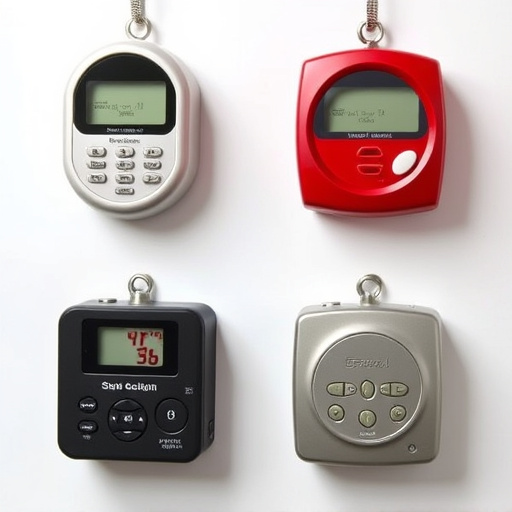Personal attack alarms, compact keychains, offer powerful defense with high-decibel (100-120 dB) sounds to startle assailants and attract help. Choose a model with adjustable sound settings for versatile protection in various environments. Prioritize a 100-120 dB range for discreet yet effective self-defense, alongside one-handed operation, long battery life, and advanced features for enhanced safety. Effective in public spaces like city streets or festivals, these alarms provide peace of mind.
“Staying safe while on the go has never been more crucial. Introducing discreet personal protection keychain alarms – compact, powerful tools designed for your peace of mind. This article guides you through understanding these mini life-savers, highlighting key features to consider, especially attack alarm sound range. We’ll explore how far your personal attack alarm can reach and share best practices for optimal self-defense. Discover real-life scenarios where these alarms prove their worth, ensuring you’re prepared for unexpected situations.”
- Understanding Discreet Personal Protection Keychain Alarms
- Key Features to Consider for Attack Alarm Sound Range
- How Far Does Your Personal Attack Alarm Reach?
- Best Practices for Discreet Self-Defense Keychains
- Real-Life Scenarios Where These Alarms Shine
Understanding Discreet Personal Protection Keychain Alarms
Discreet personal protection keychain alarms are compact yet powerful tools designed to offer immediate defense in unexpected situations. These devices, often referred to as personal attack alarms, are easily portable and can be attached to keys or bags for quick access during emergencies. Understanding the key features is essential when considering such a device.
One of the primary aspects to consider is the sound range. Personal attack alarms emit high-decibel sounds designed to startle potential assailants and attract attention from nearby bystanders. Effective personal protection alarms can reach sound levels up to 120 decibels, ensuring that the alarm’s distinct noise carries across a considerable distance. This feature, coupled with an intuitive activation mechanism, makes them reliable tools for self-defense in various settings, whether you’re walking alone or in well-lit public spaces.
Key Features to Consider for Attack Alarm Sound Range
When choosing a personal attack alarm, one of the critical factors to consider is the sound range. The alarm’s effectiveness significantly relies on its ability to attract attention over a sufficient distance. Look for alarms with high-decibel outputs, typically ranging from 120 to 130 decibels (dB). This level of volume ensures your alarm will be heard even in noisy environments or from a good distance, allowing potential bystanders to intervene and deter an attack.
Additionally, some models offer adjustable sound settings, allowing you to customize the alarm’s intensity based on your preferences and surroundings. A versatile alarm with these features provides unparalleled personal protection, offering peace of mind wherever you go.
How Far Does Your Personal Attack Alarm Reach?
The effectiveness of a personal attack alarm largely depends on its sound range and projection. These keychains are designed to emit a loud, attention-grabbing shriek that can startle an attacker and draw bystanders’ attention, but not all alarms are created equal. High-quality models often boast sound ranges of up to 120 decibels, which is approximately the same volume as a power lawnmower or a construction site. This powerful projection ensures that the alarm can be heard both indoors and outdoors, in quiet and bustling environments alike. When choosing a personal attack alarm keychain, look for specifications stating the sound range to ensure it offers the protection you need.
Best Practices for Discreet Self-Defense Keychains
When considering a discreet personal protection keychain alarm, it’s essential to understand best practices for optimal self-defense. First and foremost, ensure the device produces a distinct and powerful Personal Attack Alarm Sound within a suitable range—typically 100-120 decibels—loud enough to startle an attacker but not so loud as to draw unnecessary attention. The keychain should be easily operable with one hand, even in stressful situations, allowing for quick activation without having to search through pockets or bags.
Additionally, consider the alarm’s battery life and ease of replacement. A long-lasting battery is crucial for peace of mind; you want the device to be reliable when you need it most. Moreover, a straightforward charging process, whether via USB or wireless charging, simplifies maintenance. Lastly, some models offer additional features like a built-in flashlight or GPS tracking, enhancing your safety beyond the alarm’s immediate impact.
Real-Life Scenarios Where These Alarms Shine
In real-life situations, personal attack alarms attached to keychains have proven invaluable for self-defense. For instance, in a crowded public setting like a bustling city street or a lively festival, one false step could leave an individual vulnerable. The discreet yet powerful alarm sound can quickly attract attention and deter potential attackers, providing the user with precious time to escape or summon help.
The range of these alarms is another significant advantage. They are designed to emit a loud, piercing sound that can be heard up to 50-100 meters away, ensuring that even if the user is caught off guard, their presence is signaled, and assistance may arrive sooner rather than later. This simple yet effective tool offers peace of mind for individuals who frequently find themselves in unfamiliar or potentially dangerous environments.
Discreet personal protection keychain alarms offer a powerful, portable solution for self-defense. By understanding key features like attack alarm sound range and best practices, you can ensure these tools serve their purpose effectively in real-life scenarios. Investing in one of these compact devices could prove invaluable, providing peace of mind and an extra layer of safety when navigating unfamiliar or potentially dangerous environments.
